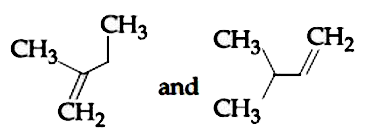When neopentyl alcohol is heated with an acid , it slowly converted into an 85 : 15 mixture of alkenes A and B , respectively. What are these alkenes ?




The correct Answer is:A
To determine the alkenes A and B formed from the dehydration of neopentyl alcohol when heated with sulfuric acid, we can follow these steps:
1. Identify Neopentyl Alcohol Structure:
Neopentyl alcohol (2,2-dimethylpropan-1-ol) has the structure:
(CH3)4C(OH)CH2 (or ) C(CH3)4CH2OH
2. Reaction with Sulfuric Acid:
When neopentyl alcohol is heated with sulfuric acid (H₂SO₄), the hydroxyl (-OH) group is protonated, making it a better leaving group. This leads to the formation of a carbocation.
3. Formation of Carbocation:
The protonation of the -OH group leads to the formation of a good leaving group (water), resulting in a carbocation. The most stable carbocation will form:
- The initial carbocation formed is a primary carbocation, but it can rearrange to form a more stable tertiary carbocation.
4. Carbocation Rearrangement:
The rearrangement occurs as follows:
- The methyl group from one of the neighboring carbon atoms can shift to stabilize the carbocation, leading to a tertiary carbocation.
5. Elimination to Form Alkenes:
From the tertiary carbocation, elimination can occur to form alkenes:
- If a hydrogen is removed from the adjacent carbon, two different alkenes can be formed:
- Alkene A (major product)
- Alkene B (minor product)
6. Identify the Alkenes:
- Alkene A (major product): 2,2-dimethylpropene (more substituted)
- Alkene B (minor product): 2-methylpropene (less substituted)
7. Determine the Ratio:
The problem states that the products are in an 85:15 ratio, which aligns with the expected stability of the alkenes formed:
- Alkene A (85%): 2,2-dimethylpropene
- Alkene B (15%): 2-methylpropene
Final Answer:
- Alkene A: 2,2-dimethylpropene
- Alkene B: 2-methylpropene
Neopentyl alcohol (2,2-dimethylpropan-1-ol) has the structure:
(CH3)4C(OH)CH2 (or ) C(CH3)4CH2OH
When neopentyl alcohol is heated with sulfuric acid (H₂SO₄), the hydroxyl (-OH) group is protonated, making it a better leaving group. This leads to the formation of a carbocation.
The protonation of the -OH group leads to the formation of a good leaving group (water), resulting in a carbocation. The most stable carbocation will form:
- The initial carbocation formed is a primary carbocation, but it can rearrange to form a more stable tertiary carbocation.
The rearrangement occurs as follows:
- The methyl group from one of the neighboring carbon atoms can shift to stabilize the carbocation, leading to a tertiary carbocation.
From the tertiary carbocation, elimination can occur to form alkenes:
- If a hydrogen is removed from the adjacent carbon, two different alkenes can be formed:
- Alkene A (major product)
- Alkene B (minor product)
- Alkene A (major product): 2,2-dimethylpropene (more substituted)
- Alkene B (minor product): 2-methylpropene (less substituted)
The problem states that the products are in an 85:15 ratio, which aligns with the expected stability of the alkenes formed:
- Alkene A (85%): 2,2-dimethylpropene
- Alkene B (15%): 2-methylpropene
- Alkene A: 2,2-dimethylpropene
- Alkene B: 2-methylpropene
Topper's Solved these Questions
Similar Questions
Knowledge Check
- Question 1 - Select One
When 3,3-Dimethyl-2-butanol is heated with acid H3PO4, it is converted into an 80:20 mixture of alkene A and B respectively. The structure of A and B are:
A B
B C
C D
D
- Question 2 - Select One
When neo-pentyl alcohol is treated with H2SO4, a mixture of two alkenes (85 : 15) is formed. Which statements is correct about these alkenes?
ABoth give same major product with HBr.BBoth give same products (major) with HBr/R2O2/light.CThe alkene which is formed in 85% concentration has higher heat of hydrogenation than the other one obtained in 15% concentration.DBoth give same product on ozonolysis. - Question 3 - Select One
When neopentyl alcohol is treted with H2SO4 , a mixture of two alkenes (85:15) is formed. Which statement (s) is /are correct about these alkenes ?
ABoth give same major products on treatment with HBrBBoth give different major products on treatment with HBr in presence of peroxideCThe alkene which is formed in 85% concentration has higher heat of hydrogenation than other alkeneDBoth alkene, on ozonolysis give same product
When vapour of an alcohols are passed over hot reduced copper, alcohol is converted into alkene the alcohol is
View SolutionWhen vapours of an alcohol are passed over hot reduced copper, alcohol is converted into alkene, the alcohol is
View SolutionWhen vapour of an alcohol are passed over hot reduced copper, alcohol is converted into alkene quickly , the alcohol is
View SolutionWhen vapours of an alcohol are passed over hot reduced copper, it gives an alkene. The alcohol is
View SolutionP is an alcohol which on heating with Al2O3 forms an alkene Q. Q on ozonolysis produces R and S. when the mixture of R and S is heated with conc. NaOH, redox reaction takes place and a mixture of an acid salt and alcohol is formed.
the alcohol (P) is obtained byView Solution

